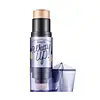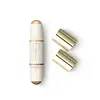Benefit Cosmetics Watt's Up! Cream Highlighter Versus KIKO Milano Gold Reflections Sculpt & Highlight Face Stick
What's inside
What's inside
 Key Ingredients
Key Ingredients

 Benefits
Benefits

 Concerns
Concerns

 Ingredients Side-by-side
Ingredients Side-by-side

Hydrogenated Polyisobutene
EmollientMica
Cosmetic ColorantEthylhexyl Palmitate
EmollientPolyethylene
AbrasiveCI 77891
Cosmetic ColorantSoybean Glycerides
EmollientSilica
AbrasiveDimethicone
EmollientTrimethylsiloxysilicate
EmollientButyrospermum Parkii Butter Unsaponifiables
Skin ConditioningCI 77492
Cosmetic ColorantCI 77491
Cosmetic ColorantCI 77499
Cosmetic ColorantLecithin
EmollientTocopherol
AntioxidantAscorbyl Palmitate
AntioxidantGlyceryl Stearate
EmollientGlyceryl Oleate
EmollientCitric Acid
BufferingHydrogenated Polyisobutene, Mica, Ethylhexyl Palmitate, Polyethylene, CI 77891, Soybean Glycerides, Silica, Dimethicone, Trimethylsiloxysilicate, Butyrospermum Parkii Butter Unsaponifiables, CI 77492, CI 77491, CI 77499, Lecithin, Tocopherol, Ascorbyl Palmitate, Glyceryl Stearate, Glyceryl Oleate, Citric Acid
Hydrogenated Polyisobutene
EmollientMica
Cosmetic ColorantEthylhexyl Palmitate
EmollientSynthetic Wax
AbrasiveSynthetic Fluorphlogopite
Soybean Glycerides
EmollientSilica
AbrasiveDimethicone
EmollientTrimethylsiloxysilicate
EmollientButyrospermum Parkii Butter Unsaponifiables
Skin ConditioningTocopherol
AntioxidantTin Oxide
AbrasiveJasminum Officinale Flower Wax
EmollientRosa Moschata Seed Oil
EmollientAscorbyl Palmitate
AntioxidantParfum
MaskingCI 77891
Cosmetic ColorantCI 77491
Cosmetic ColorantOctyldodecanol
EmollientSqualane
EmollientCellulose
AbsorbentCoco-Caprylate/Caprate
EmollientLauroyl Lysine
Skin ConditioningTribehenin
EmollientHydrogenated Ethylhexyl Olivate
EmollientJojoba Esters
EmollientCaprylic/Capric Triglyceride
MaskingBis-Behenyl/Isostearyl/Phytosteryl Dimer Dilinoleyl Dimer Dilinoleate
EmollientHydrogenated Castor Oil
EmollientButyrospermum Parkii Butter
Skin ConditioningDipalmitoyl Hydroxyproline
Skin ConditioningPolyhydroxystearic Acid
EmulsifyingLimnanthes Alba Seed Oil
Skin ConditioningStearalkonium Hectorite
Gel FormingSodium Hyaluronate
HumectantPropylene Carbonate
SolventKaolin
AbrasiveVanillin
MaskingCI 77007
Cosmetic ColorantHydrogenated Polyisobutene, Mica, Ethylhexyl Palmitate, Synthetic Wax, Synthetic Fluorphlogopite, Soybean Glycerides, Silica, Dimethicone, Trimethylsiloxysilicate, Butyrospermum Parkii Butter Unsaponifiables, Tocopherol, Tin Oxide, Jasminum Officinale Flower Wax, Rosa Moschata Seed Oil, Ascorbyl Palmitate, Parfum, CI 77891, CI 77491, Octyldodecanol, Squalane, Cellulose, Coco-Caprylate/Caprate, Lauroyl Lysine, Tribehenin, Hydrogenated Ethylhexyl Olivate, Jojoba Esters, Caprylic/Capric Triglyceride, Bis-Behenyl/Isostearyl/Phytosteryl Dimer Dilinoleyl Dimer Dilinoleate, Hydrogenated Castor Oil, Butyrospermum Parkii Butter, Dipalmitoyl Hydroxyproline, Polyhydroxystearic Acid, Limnanthes Alba Seed Oil, Stearalkonium Hectorite, Sodium Hyaluronate, Propylene Carbonate, Kaolin, Vanillin, CI 77007
Ingredients Explained
These ingredients are found in both products.
Ingredients higher up in an ingredient list are typically present in a larger amount.
Ascorbyl Palmitate is created by combining pure Vitamin C and palmitic acid. It is an antioxidant and helps reduce hyperpigmentation.
This ingredient is a more stable version of Vitamin C, meaning it does not disintegrate as quickly when exposed to sunlight. However, studies show it does not penetrate skin as well as pure Vitamin C.
Ascorbyl Palmitate is oil soluble.
Read more about other types of Vitamin C:
Learn more about Ascorbyl PalmitateButyrospermum Parkii Butter Unsaponifiables comes from shea butter.
Unsaponifiables means the butter is not saponified, or it has not been turned into soap using an alkali reaction.
This ingredient contains Vitamin E, sterols, and many antioxidants. These compounds help hydate your skin.
Learn more about Butyrospermum Parkii Butter UnsaponifiablesCi 77491 is also hydrated iron III oxide. It's sole purpose is to give a red/pink hue to products.
Iron III oxides are classified as inorganic chemicals for coloring.
Synthetically created Ci 77491 is considered safer than those naturally found. This is because the synthetically created version may contain less impurities. Iron oxides are generally non-toxic and non-allergenic.
Learn more about CI 77491Ci 77891 is a white pigment from Titanium dioxide. It is naturally found in minerals such as rutile and ilmenite.
It's main function is to add a white color to cosmetics. It can also be mixed with other colors to create different shades.
Ci 77891 is commonly found in sunscreens due to its ability to block UV rays.
Learn more about CI 77891Dimethicone is a type of synthetic silicone created from natural materials such as quartz.
What it does:
Dimethicone comes in different viscosities:
Depending on the viscosity, dimethicone has different properties.
Ingredients lists don't always show which type is used, so we recommend reaching out to the brand if you have questions about the viscosity.
This ingredient is unlikely to cause irritation because it does not get absorbed into skin. However, people with silicone allergies should be careful about using this ingredient.
Note: Dimethicone may contribute to pilling. This is because it is not oil or water soluble, so pilling may occur when layered with products. When mixed with heavy oils in a formula, the outcome is also quite greasy.
Learn more about DimethiconeEthylhexyl Palmitate, also known as octyl palmitate, is created from 2-ethylhexyl alcohol and palmitic acid. It is a fatty acid ester.
The fatty acid content of Ethylhexyl Palmitate makes it an emollient. Emollients help soften and hydrate your skin by trapping moisture within.
Ethylhexyl Palmitate is also used to help improve the texture of cosmetics. It helps other ingredient dissolve in products and help disperse ingredients more evenly.
You'll likely find this ingredient in sunscreen, as it is often used to mix UV-blocking ingredients such as avobenzone and ethylhexyl triazone.
It can also help stabilize the fragrances in a product as a fragrance fixative.
Ethylhexyl Palmitate can be used to substitute mineral oil.
Due to its high fatty acid content, it may not be fungal-acne safe.
Learn more about Ethylhexyl PalmitateHydrogenated Polyisobutene is a synthetic polymer. Polymers are compounds with high molecular weight. Hydrogenated Polyisobutene is an emollient and texture enhancer.
In one study, Hydrogenated Polyisobutene showed better skin hydration levels than Caprylic/Capric Triglyceride. As an emollient, it helps keep your skin soft and hydrated by trapping moisture in.
Hydrogenated Polyisobutene is often used as a mineral oil replacement.
Learn more about Hydrogenated PolyisobuteneMica is a naturally occurring mineral used to add shimmer and color in cosmetics. It can also help improve the texture of a product or give it an opaque, white/silver color.
Serecite is the name for very fine but ragged grains of mica.
This ingredient is often coated with metal oxides like titanium dioxide. Trace amounts of heavy metals may be found in mica, but these metals are not harmful in our personal products.
Mica has been used since prehistoric times throughout the world. Ancient Egyptian, Indian, Greek, Roman, Aztec, and Chinese civilizations have used mica.
Learn more about MicaSilica, also known as silicon dioxide, is a naturally occurring mineral. It is used as a fine, spherical, and porous powder in cosmetics.
Though it has exfoliant properties, the function of silica varies depending on the product.
The unique structure of silica enhances the spreadability and adds smoothness, making it a great texture enhancer.
It is also used as an active carrier, emulsifier, and mattifier due to its ability to absorb excess oil.
In some products, tiny microneedles called spicules are made from silica or hydrolyzed sponge. When you rub them in, they lightly polish away dead skin layers and enhance the penetration of active ingredients.
Learn more about SilicaWe don't have a description for Soybean Glycerides yet.
Tocopherol (also known as Vitamin E) is a common antioxidant used to help protect the skin from free-radicals and strengthen the skin barrier. It's also fat soluble - this means our skin is great at absorbing it.
Vitamin E also helps keep your natural skin lipids healthy. Your lipid skin barrier naturally consists of lipids, ceramides, and fatty acids. Vitamin E offers extra protection for your skin’s lipid barrier, keeping your skin healthy and nourished.
Another benefit is a bit of UV protection. Vitamin E helps reduce the damage caused by UVB rays. (It should not replace your sunscreen). Combining it with Vitamin C can decrease sunburned cells and hyperpigmentation after UV exposure.
You might have noticed Vitamin E + C often paired together. This is because it is great at stabilizing Vitamin C. Using the two together helps increase the effectiveness of both ingredients.
There are often claims that Vitamin E can reduce/prevent scarring, but these claims haven't been confirmed by scientific research.
Learn more about TocopherolThis silicone is an emollient. Emollients create a thin film on the skin to prevent moisture from escaping.
It is not soluble in water and helps increase water-resistance in products.
According to a manufacturer, it can blend seamlessly with silicone oils, such as Cyclopentasiloxane.
Learn more about Trimethylsiloxysilicate